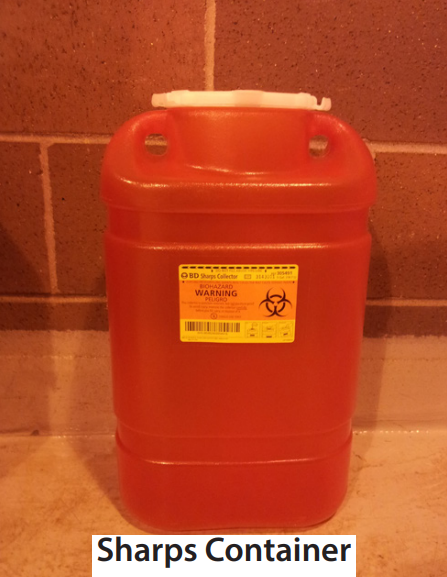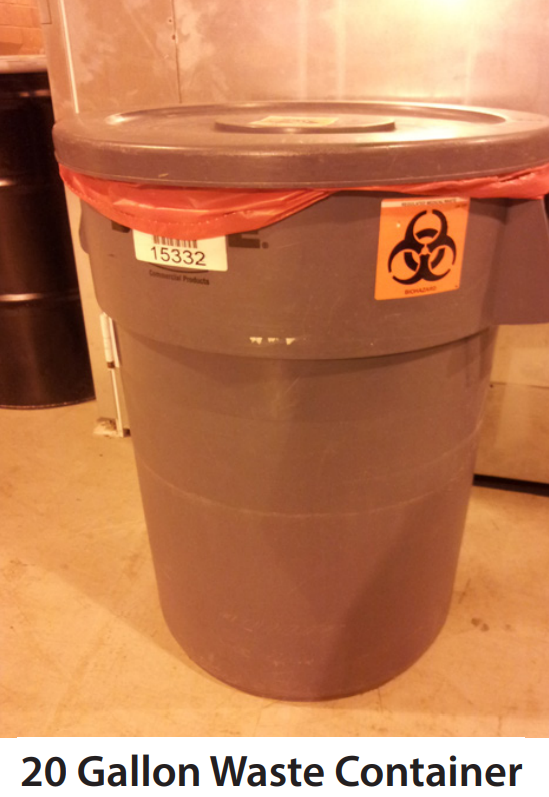All Biohazardous Waste or waste containing BSL-2 recombinant or synthetic nucleic acid molecules must be disinfected prior to disposal.
Biohazardous and BSL-2 recombinant or synthetic nucleic acid waste
Biohazardous wastes are laboratory wastes that are considered infectious or potentially infectious to humans and are produced as a result of Biosafety Level -2 (BSL-2) work, including work with most recombinant viral vector systems. Your laboratory should have written Standard Operating Procedures (SOPs) for the handling and disposal of biohazardous waste as part of an Exposure Control Plan or Biosafety Manual. If you need assistance developing these contact the Biosafety Officer (801-581-6590).
Biohazardous waste includes
- Waste from experiments with BSL-2 recombinant viral vectors, including plates, flasks, pipets and media
- Human or non-human primate specimen cultures and cells (including established cell lines)
- Cultures and wastes from the production of Risk Group 2 bacteria, viruses, spores, and discarded live and attenuated vaccines
- Recognizable human anatomical parts (must be labeled “Pathology Waste – For Incineration Only")
- Tissues, fluids or carcasses from non-human primates or from animals exposed to pathogenic agents, viral viral vectors or toxins requiring BSL-2 containment
- Acute Biological Toxins
The Environmental Health and Safety (EHS) Safety Administrative Management (SAM) system, allows research investigators to request hazardous material pickups by EHS staff and request empty containers. Please visit the SAM website for information.
Waste containers obtained from EHS are solid sided, leak proof, lined with red biohazard bags, and labeled with a biohazard symbol. Keep the container lid closed unless someone is working nearby and regularly adding waste to the container.
When the red bag is ¾ full, loosely tie or tape the bag closed. Secure the lid on the waste container and move it to a convenient storage location or transport it to a biohazardous waste storage room, if available. Biohazardous waste must be moved or transported inside a rigid, leak- resistant, labeled container with the lid closed. Request a pickup from your lab using the SAM system.
If you have an autoclave available for disinfection of biohazardous waste, place a red biohazard bag in a solid puncture resistant container. Place a Ziploc bag or balloon containing water in the bag when it is about half full to generate steam during autoclaving. When the red bag is full, tie or tape the bag closed. Secure the lid on the waste container and move it to the autoclave room.
The bag should be removed and placed in a solid autoclave resistant tray: the bag should NEVER be placed directly on the floor. After the cycle, the bag may be disposed of as regular trash: indicators that the contents have been autoclaved must be present.
Aspirated tissue culture media and other liquid waste generated from BSL-2 experiments must be disinfected and then disposed. Bleach is typically used to disinfect liquids, but other agents, such as Vesphene III, may be used if effective.
If you use bleach:
- Ensure the final concentration exceeds 0.5% sodium hypochlorite (no less than one part bleach to 9 parts liquid)
- Ensure the bleach is fresh: in tissue culture media traps change at least twice weekly
- Ensure the media is exposed to disinfectant for at least 20 minutes prior to disposal
- Dispose down the sink
If you use Vesphene III
- Ensure the final concentration exceeds 1% (no less than one part Vesphene to 99 parts liquid)
- In tissue culture media traps change at least every 3 months (indicate the date of the last change on the flask)
- Ensure the media is exposed to disinfectant for at least 20 minutes prior to disposal
- Collect waste into containers marked “Unwanted Materials” and date when you start collecting. When full or 6 months after your start date (whichever happens first), arrange pickup by EHS through the SAM website. NO DRAIN DISPOSAL
If the container will be unattended (outside of your immediate control) then label
it with the date, time and the words “Biohazardous liquid” and keep it in a secondary
container (for example, a plastic tub) while it is disinfecting.
If you use other agents to decontaminate liquid cultures follow the instructions on the packaging. Contact the Biosafety Officer (801-581-6590) for advice on appropriate disinfectants and procedures for disposal of treated waste.
Mixed liquid and solid waste should be separated in a biosafety cabinet (decant the liquid from the solid). Manage the liquids and solids separately as detailed in this fact sheet.
A sharp is any device having corners, edges, or projections capable of cutting or piercing. Sharps include, but are not limited to, the following
- Needles
- Needles with syringes and attached tubing
- Blades (razors, scalpels and X-acto®)
- Pasteur pipettes
- Broken glass, glass slides, and cover slips
Use a Food and Drug Administration (FDA)-cleared sharps container if you generate sharps waste (pictured below). A description of FDA-Cleared Sharps containers can be found here. FDA-cleared sharps disposal containers are made from rigid plastic, come marked with a line that indicates when the container should be considered full, which means it’s time to dispose of the container, and have the Universal Biohazard symbol.

Serological pipets (glass and plastic) and disposable pipet tips are considered puncture hazards and should be disposed of as sharps. BSL2 contaminated pipets and tips should be discarded in approved sharps containers, as described above.
Due to the large size of serological pipets, investigators disposing of large numbers of these can request 20 gallon hard-sided biohazard waste containers (pictured next column) from EHS through the SAM. These will be picked up by EHS staff as for other biohazardous waste.

It is possible to decontaminate serological pipets and tips prior to disposal. Ensure that both the inside and outside of the pipets or tips are exposed to the approved disinfectant (e.g. a freshly prepared 1:10 dilution of bleach) for at least 20 minutes. However, serological pipets and disposable tips are still considered puncture hazards. Therefore, after removing the disinfectant, they can be disposed of in a Broken Glass box (rigid puncture resistant boxes lined with a plastic bag and labeled “Broken Glass”: pictured below), which can be obtained from your custodial staff or from EHS. Once they are 2/3 full they should closed with tape and disposed as regular trash by your custodians.

